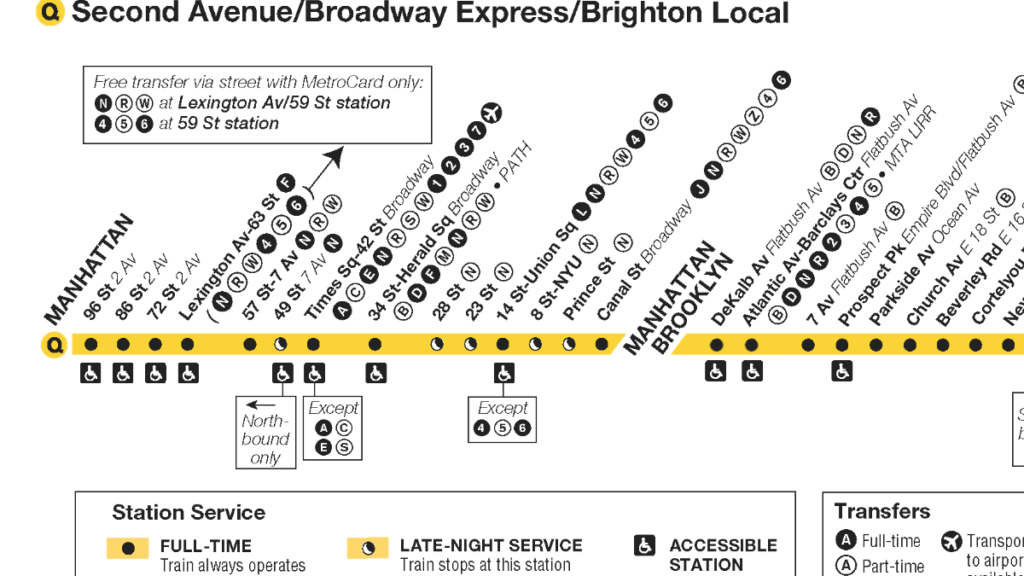Monday, August 21, 2023 – HOW WELL DO YOU KNOW CENTRAL PARK?


Many of our neighbors are very confused about the upcoming subway project. This is a simplified map and listings of the route of the Q train.
The Q train operates from 63 St./Lexington Ave. on tracks just across from the F train.
The Q train operates mostly on 7th Avenue and can easily accommodate our transportation needs.
Please send your comments to:rooseveltislandhistory@gmail.com

STARTING AUGUST 28
| THE F TRAIN SHUTTLE IS A TRAIN. THERE IS A LOT OF CONFUSSION BETWEEN BUS AND TRAIN SHUTTLES DURING THE WEEK FROM 5 A.M. TO MIDNIGHT THERE IS A TRAIN SHUTTLE FROM OUR STATION The “F”SHUTTLE TRAIN WILL ONLY RUN BETWEEN 21 ST/QUEENSBRIDGE, ROOSEVELT ISLAND TO LEXINGTON AVE./63 ST. STATIONS. THERE IS ONE “F” SHUTTLE TRAIN ON ONE TRACK GOING BACK AND FORTH FROM 5 A.M. TO MIDNIGHT DURING THE WEEK. THERE ARE NO TRAINS GOING EAST TO QUEENS AFTER QUEENSBRIDGE. THERE ARE BUS CONNECTIONS FROM THAT STATION OPERATED BY THE MTA. |

Q TRAIN CONNECTIONS AVAILABLE FROM 63/LEX STATION SOUTHBOUND
Q TRAIN TO 57 STREET & 7 AVENUE
Q TRAIN TO 42 STREET TIMES SQUARE (CONNECT HERE TO F TRAIN VIA PASSAGE)
Q TRAIN TO 34 STREET (CONNECT HERE TO F TRAIN)
Q TRAIN TO 14 STREET UNION SQUARE
Q TRAIN TO CANAL STREET (OVER MANHATTAN BRIDGE TO BROOKLYN)
Q TRAIN CONNECTIONS AVAILABLE FROM 63/LEX STATION NORTHBOUND (72 ST., 86 ST., 96 ST AT SECOND AVENUE)
Overnights between midnight and 5 a.m., F shuttle train service is suspended and free Q94 shuttle buses will connect the Roosevelt Island, 21 St-Queensbridge, and Queens Plaza stations. These are MTA buses.
FROM THE ARCHIVES
MONDAY AUGUST 21, 2023
ISSUE# 1066
SECRETS OF
CENTRAL PARK
UNTAPPED NEW YORK

Even though Central Park is one of New York City’s most famous attractions, its 800+ acres of sprawling meadows, forests, rocky outcroppings, lawns, and bodies of water still hold many secrets waiting to be unveiled. We’ve covered the history of Central Park and its many hidden gems in a variety of different articles, from exploring what wasn’t in the original plan to shedding light on the work of the park’s overlooked architect.

Unless you’re obsessed with lamp posts, you probably haven’t noticed the embossed numbers that are on a metal plaque bolted on each of Central Park’s cast iron lampposts, designed by Henry Bacon. The plaques can be either on the base or on the post itself, oriented appropriately. The first two or three digits actually denote the nearest cross street, and the last digit tells you if you’re closer to the east or west side of the park. An even number means east, an odd number means west.

The Conservatory Garden is a quiet, lesser-traveled part of the park where you can enjoy a peaceful stroll through French, English, and Italian gardens. From 1898 until 1934, this area was covered by a massive glass conservatory (hence the name). Visitors enter the garden through massive wrought-iron gates. These gates were once part of the estate of Cornelius Vanderbilt II. Designed by George B. Post and forged in Paris in 1894, the gates survived the estate’s demolition in the 1920s. Bergdorf Goodman stands where the mansion once was on the corner of 57th Street and 5th Avenue. Vanderbilt‘s daughter, Gertrude Vanderbilt Whitney donated the gates to Central Park in 1939.

There are at least five waterfalls in Central Park, all completely man-made. Most of them are located in the Ravine. The water that flows here is actually New York City drinking water that comes from a 48-inch pipe hidden by the rocks at the Pool Grotto on West 100th Street.

When Central Park was built, the city planted more than 270,000 trees and shrubs and preserved a handful of trees that were original to the area. Today, only about 150 trees are left from the time of Olmsted and Vaux, but many of the trees acquired over the years have a unique story. These Yoshino Cherry trees along the east side of the Reservoir may be the original trees presented as a gift to the United States by Japan in 1912. They are among the first trees to bloom in the spring, before the Kwanzan Cherry. The delicate blossoms drop quickly before the trees green out, and stay leafy for the rest of the season.
MONDAY PHOTO OF THE DAY
SEND YOUR RESPONSE TO:
ROOSEVELTISLANDHISTORY@GMAIL.COM

WEEKEND PHOTO
MC GOWAN’S TAVERN CENTRAL PARK

Text by Judith Berdy
Thanks to Bobbie Slonevsky for her dedication to Blackwell’s Almanac and the RIHS
UNTAPPED NEW YORK
JUDITH BERDY
Thanks to Deborah Dorff for maintaining our website
Edited by Melanie Colter and Deborah Dorff
MAYA LEVANON-PHOTOS TIK TOK & INSTAGRAM
All image are copyrighted (c) Roosevelt Island Historical Society unless otherwise indicated
www.tiktok.com/@rooseveltislandhsociety
Instagram roosevelt_island_history
THIS PUBLICATION FUNDED BY DISCRETIONARY FUNDS FROM CITY COUNCIL MEMBER JULIE MENIN & ROOSEVELT ISLAND OPERATING CORPORATION PUBLIC PURPOSE FUNDS.


Copyright © 2022 Roosevelt Island Historical Society, All rights reserved.Our mailing address is:
rooseveltislandhistory@gmail.com

Leave a comment